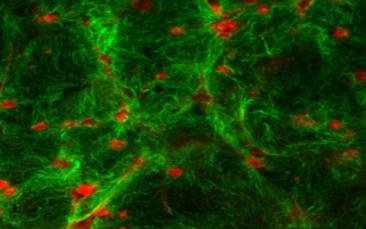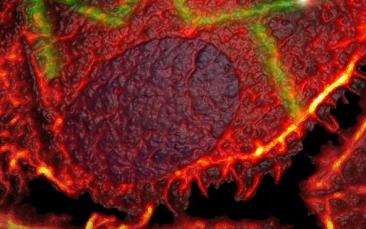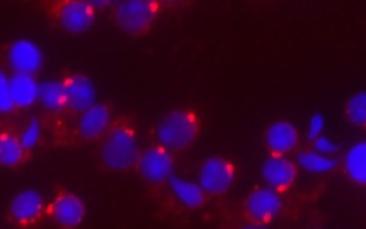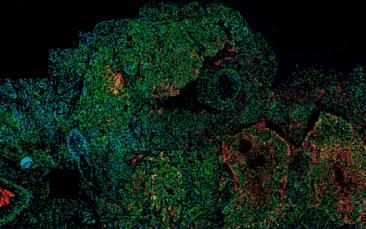All science stories
Showing results 1 to 6
6
-

A new weapon against pancreatic cancer on the way ?
Tamoxifen, a drug used in breast cancer treatment, may be repositioned to treat pancreatic cancerPancreatic cancer is the 4th leading cause of death by cancer in Europe. It has a very low survival rate with less than 1 per cent of sufferers…Tamoxifen, a drug used in breast cancer treatment, may be repositioned to treat pancreatic cancerPancreatic cancer is the 4th leading cause of death by cancer in Europe. It has a very…Tamoxifen, a drug used in breast cancer treatment, may be repositioned to treat pancreatic cancerPancreatic cancer is the 4th leading cause of death…Tamoxifen, a drug used in breast cancer treatment, may be repositioned to treat pancreatic cancerPancreatic cancer is the 4th leading cause of death by cancer in Europe. It…Tamoxifen, a drug used in breast cancer treatment, may be repositioned to treat pancreatic cancerPancreatic cancer is the… -
Putting the CRISPR back in bacteria
CRISPR is a widely used molecular biology tool exploiting an immune process discovered in bacteria. Dr David Bikard studies CRISPR in bacterial cells, in conjunction with different DNA repair systems, to create even newer tools. He hopes to gain…CRISPR is a widely used molecular biology tool exploiting an immune process discovered in bacteria. Dr David Bikard studies CRISPR in bacterial cells, in conjunction with different DNA…CRISPR is a widely used molecular biology tool exploiting an immune process discovered in bacteria. Dr David Bikard studies CRISPR in bacterial cells…CRISPR is a widely used molecular biology tool exploiting an immune process discovered in bacteria. Dr David Bikard studies CRISPR in bacterial cells, in conjunction with…CRISPR is a widely used molecular biology tool exploiting an immune process discovered in bacteria. Dr David Bikard studies… -

Molecular tattooing for local, targeted drug-delivery
Dr Málnási-Csizmadia focuses on enzymes, proteins essential for body functions, and the largely unexplored intricate mechanisms underlying their activity. His recent findings could open the way to a ground-breaking development in pharmacology,…Dr Málnási-Csizmadia focuses on enzymes, proteins essential for body functions, and the largely unexplored intricate mechanisms underlying their activity. His recent findings could…Dr Málnási-Csizmadia focuses on enzymes, proteins essential for body functions, and the largely unexplored intricate mechanisms underlying their…Dr Málnási-Csizmadia focuses on enzymes, proteins essential for body functions, and the largely unexplored intricate mechanisms underlying their activity. His recent findings…Dr Málnási-Csizmadia focuses on enzymes, proteins essential for body functions, and the largely unexplored intricate… -

Major breakthrough could help detoxify pollutants
Scientists at the University of Manchester (UK) hope a major breakthrough could lead to more effective methods for detoxifying dangerous pollutants like PCBs (polychlorinated biphenyls) and dioxins. The result is a culmination of 15 years of…Scientists at the University of Manchester (UK) hope a major breakthrough could lead to more effective methods for detoxifying dangerous pollutants like PCBs (polychlorinated biphenyls…Scientists at the University of Manchester (UK) hope a major breakthrough could lead to more effective methods for detoxifying dangerous pollutants…Scientists at the University of Manchester (UK) hope a major breakthrough could lead to more effective methods for detoxifying dangerous pollutants like PCBs (polychlorinated…Scientists at the University of Manchester (UK) hope a major breakthrough could lead to more effective methods for… -

Unveiling how our genome is protected
Conducting research in small RNAs, Dr. Ramesh Pillai attempts to understand how the genome protects itself from an internal threat, namely ‘transposons’ or ‘jumping genes’ which can cause mutations. Awarded an ERC Starting grant in 2010, Dr. Pillai…Conducting research in small RNAs, Dr. Ramesh Pillai attempts to understand how the genome protects itself from an internal threat, namely ‘transposons’ or ‘jumping genes’ which can…Conducting research in small RNAs, Dr. Ramesh Pillai attempts to understand how the genome protects itself from an internal threat, namely …Conducting research in small RNAs, Dr. Ramesh Pillai attempts to understand how the genome protects itself from an internal threat, namely ‘transposons’ or ‘jumping genes’…Conducting research in small RNAs, Dr. Ramesh Pillai attempts to understand how the genome protects itself from an internal… -

Ageing, cancer and the length of your chromosomes
The answer to why some people age earlier than others, or why they develop cancer, could lie at the very end sections of our DNA: the telomeres.The answer to why some people age earlier than others, or why they develop cancer, could lie at the very end sections of our DNA: the telomeres.The answer to why some people age earlier than others, or why they develop cancer, could lie at the very end sections of our DNA: the telomeres.The answer to why some people age earlier than others, or why they develop cancer, could lie at the very end sections of our DNA: the telomeres.The answer to why some people age earlier than others, or why they develop cancer, could lie at the very end sections of our…
